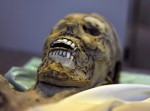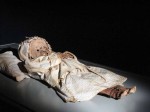A group of 265 mummies currently in the Hungarian Natural History Museum are being studied by medical researchers looking for new ways to combat tuberculosis. Tuberculosis killed 1.5 million people in 2010, and fully a third of the world population is infected but asymptomatic. The vaccine doesn’t work in many places where TB is endemic and antibiotics are increasingly powerless to combat the disease. It takes a six month regimen of antibiotics to battle tuberculosis; many people never complete the program. That only gives the bacterium more opportunities to become resistant to even the strongest and longest antibiotics. The group of well-preserved mummies from the 1700s and early 1800s, when tuberculosis was sweeping the continent as the White Plague, can provide invaluable information about the bacterium and our natural defenses against it.
 Two hundred and sixty-five town residents — among them merchants, nuns, 30 priests, surgeons, craftsmen, and the postmaster’s wife and child — were interred in the crypt of the Church of the Whites in the northern Hungary town of Vác between 1731 and 1838. The cool air, low moisture and the bacteria- and fungi-killing pine oil from their wood coffins combined to create ideal natural mummification conditions, but nobody noticed because the vault had been bricked up and forgotten.
Two hundred and sixty-five town residents — among them merchants, nuns, 30 priests, surgeons, craftsmen, and the postmaster’s wife and child — were interred in the crypt of the Church of the Whites in the northern Hungary town of Vác between 1731 and 1838. The cool air, low moisture and the bacteria- and fungi-killing pine oil from their wood coffins combined to create ideal natural mummification conditions, but nobody noticed because the vault had been bricked up and forgotten.
 In 1994, a worker investigating the source of some cracks in the church wall found a spot that sounded hollow when he tapped on it with a hammer. After a few more taps, the wall began to collapse and the builder realized it was only a single brick thick. He broke through and found a stone staircase leading into the inky darkness. He and the priest went down the stairs and found an enormous crypt packed to the ceiling with elaborately painted coffins stacked from largest to smallest.
In 1994, a worker investigating the source of some cracks in the church wall found a spot that sounded hollow when he tapped on it with a hammer. After a few more taps, the wall began to collapse and the builder realized it was only a single brick thick. He broke through and found a stone staircase leading into the inky darkness. He and the priest went down the stairs and found an enormous crypt packed to the ceiling with elaborately painted coffins stacked from largest to smallest.
 The priest, recognizing their rarity and significance — coffins don’t often survive above ground in pristine condition for hundreds of years — called in ethnographers to examine them. They looked inside the coffins and found the mummified remains and everything they were buried with. The crypt’s microclimate had preserved the clothing they were laid to rest in, from wool socks to bonnets to military uniforms, plus rosaries, ribbons and crowns of rosemary.
The priest, recognizing their rarity and significance — coffins don’t often survive above ground in pristine condition for hundreds of years — called in ethnographers to examine them. They looked inside the coffins and found the mummified remains and everything they were buried with. The crypt’s microclimate had preserved the clothing they were laid to rest in, from wool socks to bonnets to military uniforms, plus rosaries, ribbons and crowns of rosemary.
 The mummies were transferred to the Hungarian Natural History Museum in Budapest where experts took X-rays of the mummies. They found evidence of tuberculosis on the bones. Dr. Ildiko Pap, director of anthropology at the Natural History Museum, contacted Professor Mark Spigelman, a surgeon who has pioneered the study of tuberculosis in archaeological remains, and told him he had almost 300 mummies to examine. Dr. Spigelman has done wonders discovering tuberculosis DNA preserved in the ancient tissues of the handful of mummies he’s had access to; having such a large group to study is a unique opportunity.
The mummies were transferred to the Hungarian Natural History Museum in Budapest where experts took X-rays of the mummies. They found evidence of tuberculosis on the bones. Dr. Ildiko Pap, director of anthropology at the Natural History Museum, contacted Professor Mark Spigelman, a surgeon who has pioneered the study of tuberculosis in archaeological remains, and told him he had almost 300 mummies to examine. Dr. Spigelman has done wonders discovering tuberculosis DNA preserved in the ancient tissues of the handful of mummies he’s had access to; having such a large group to study is a unique opportunity.
 Tissue samples found evidence of tuberculosis infection in 89% of the mummies. Studying centuries-old TB might also give us an idea of how drug-resistant strains develop and how we can combat them in the short term. Only 35% of the Vác mummies appear to have died from the disease. Since there was no vaccine and no antibiotic treatment, the 65% who were not felled by the disease could prove to have had a genetic resistance, opening the door to a potential gene therapy for tuberculosis in the long term.
Tissue samples found evidence of tuberculosis infection in 89% of the mummies. Studying centuries-old TB might also give us an idea of how drug-resistant strains develop and how we can combat them in the short term. Only 35% of the Vác mummies appear to have died from the disease. Since there was no vaccine and no antibiotic treatment, the 65% who were not felled by the disease could prove to have had a genetic resistance, opening the door to a potential gene therapy for tuberculosis in the long term.